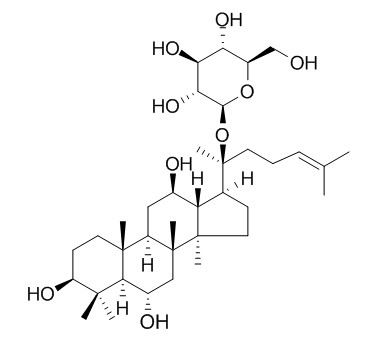Natural Products
Ginsenoside F1
| Catalog No. | CFN99754 |  |
| CAS No. | 53963-43-2 | |
| Molecular Weight: | 638.88 | |
| Molecular Formula | C36H62O9 | |
| DBs | [PubChem]:274951197 [ChEMBL]:77150 [PCIDB]:30388 |
Standard InChI:
InChI=1S/C36H62O9/c1-19(2)10-9-13-36(8,45-31-29(43)28(42)27(41)23(18-37)44-31)20-11-15-34(6)26(20)21(38)16-24-33(5)14-12-25(40)32(3,4)30(33)22(39)17-35(24,34)7/h10,20-31,37-43H,9,11-18H2,1-8H3/t20-,21+,22-,23+,24+,25-,26-,27+,28-,29+,30-,31-,33+,34+,35+,36-/m0/s1
Biological Activity
Ginsenoside (G)-F1 is an enzymatic metabolite generated from G-Rg1, it has been reported to suppress platelet aggregation and to reduce gap junction-mediated intercellular communication, also as a novel anti-skin cancer drug with anti-proliferative and anti-migration features.[1]
Ginsenoside F1 significantly reduces ultraviolet-B-induced cell death by maintaining constant levels of Bcl-2 and protects HaCaT cells from apoptosis caused by ultraviolet B irradiation. [2]
Ginsenoside F1(GF1) has beneficial effects on skin, it reduces α-melanocyte-stimulating hormone-induced melanin secretion in B16F10 cell culture media by 60%, but does not suppress intracellular melanin levels, tyrosinase activity and expression; it primarily modulates the Rho family GTPases resulting in dendrite retraction, suggests that GF1 could act as a potent skin-whitening agent.[3]
Ginsenoside F1 has inhibitory effect of elastase and tyrosinase, indicates that ginsenoside F1 have a potential for industrial cosmetic materials.[4]
Product
References
[1] Yoo D S, Rho H S, Yong G L, et al. J Ginseng Res, 2011, 35(1):86-91.
[2] Lee E H, Cho S Y, Kim SJShin E S, et al.J Invest Dermatol, 2003, 121(3):607-13.
[3] Ji H K, Baek E J, Lee E J, et al. Exp Dermatol, 2014, 24(2):150-2.
[4] Hong, S.C., Korean J Pharm, 2013, 44(1):10-5.
[5] Chong G, Gao Y G, Pu Z, et al. Chinese Trad Herbal Drugs, 2014, 45(14):2009-13.
Product Use Citation





